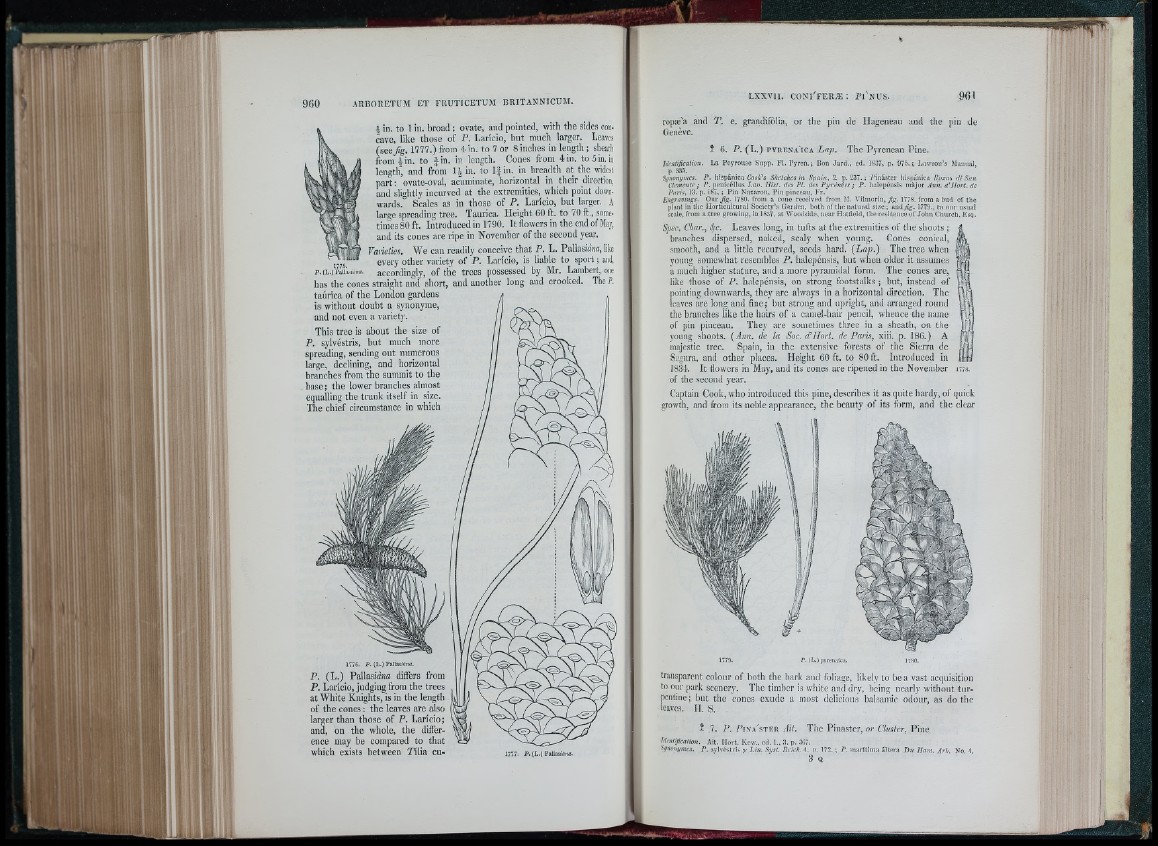
i in. to I in. broad ; ovate, and pointed, with the sides concave,
like those of P. Laricio, but much larger. Leaves
(see fig. 1777.) from 4 in. to 7 or 8 inches in length ; sheath
from 4 in. to f '" - >" length. Cones from 4 in. to 5 in, in
length, and from 1 J in. to Ifin . in breadth at the widest
part: ovate-oval, acuminate, horizontal in their direction,
and slightly incurved at the extremities, which point downwards.
Scales as in those of P. Laricio, but larger. A
large spreading tree. Taurica. Height 60 ft. to 70 ft,, some-
times 80 ft. Introducedin 1790. It flowers in the end of May,
and its cones are ripe in November of the second year.
Varieties. We can readily conceive that P. L. Pallasiàiio, like
, , , 5 every other variety of P . Laricio, is liable to sport ; and,
p. (L.) paiú.«.». accordingly, of the trees possessed by Mr. Lambert, one
has the cones straight and short, and another long and crooked. The P,
taurica of the London gardens
is without doubt a synonyme,
and not even a variety.
This tree is about the size of
P. sylvéstris, but much more
spreading, sending out numerous
large, declining, and horizontal
branches from the summit to the
base ; the lower branches almost
equalling the trunk itself in size.
The chief circumstance in which
1776. P . (L.) Pallasidna.
P. (L.) Pallasiana differs from
P. Laricio, judging from the trees
at White Knights, is in the length
of the cones: the leaves are also
larger than those of P. Laricio;
and, on the whole, the difference
may be compared to that
which exists between Pilia europæ'a
and T. e. gi'andifòlia, or the pin de Hageneau and tlie pin de
Ocnève.
Î 6 . P. (L.) p y r e n a ' i c a Lap. The Pyrenean Pine.
Identification. La Peyroiisc Supp. F l.r y re n . ; Bon Jard., ed. 1837, p. 975.; Lawson’s Manual,
p. 835.
Si/nony»ies. P. hispánica Coolfs Sketches in Spain, 2. p. 237. : /Ín á s te r hispánica Ruxns di San
' Clemente ; P. penicéllus I.ap. Hixf. des Pl. des Pyrénées ; P. halepénsis màjor Ann. d'Hort. dc
Paris, 13. p. Ì87. ; Pin Nazaron, Pin pinceau, Fr.
Engravings. Our fig. 1780. from a cone received from M. Vilmorin, fig. 1778. from a biul of the
plant in tlie Horticultural Society’s Garden, both of tbe natural size ; and/g-. 177Í)., Co our usual
scale, from a .tree growing, in 1837, at Woodside, near Hatfield, thc residence of John Church, Esq.
Spec, Char., cÿc. Leaves long, in tufts at the extremities of the shoots ;
branches dispersed, naked, scaly when young. Cones conical,
smooth, and a little recurved, seeds hard. (L a p .) The tree when
young somewhat resembles P. halepénsis, but when oldei’ it assumes
a nmch higher stature, and a more pyramidal form. The cones are,
like those of F, halepénsis, on strong footstalks ; but, instead of
pointing downwards, they are always in a horizontal direction. The
leaves are long and fine; but strong and upright, and arranged round
the branches like the hairs of a camel-hair pencil, whence the name
of pin pinceau. They are sometimes three in a shcatli, on the
young shoots. {Ann. de la Soc. d’Hort. de Paris, xiii. p. 186.) A
majestic tree. Spain, in the extensive forests of the Sierra de
Segura, and other places. Height 60 ft. to 80 ft. Introduced in
1834. It flowers in May, and its cones are ripened in the November
of the second year.
Captain Cook, who introdaced thi.s pine, describes it as quite hardy, of quick
growth, and from its noble appearance, the beauty of its ffòòirm, and the clear
transparent colour of both the bark and foliage, likelv to be a vast acqui.sition
to our park scenery. The timber is wliite and dry, being nearly without turpentine;
but the cones exude a ino.st delicious balsaniie odour, as do tlie
leaves, n . S.
Í 7 . P. P in a ' s t k r Ait. The Pinaster, or Cluster, Pine
Identification. Alt, Hort. Kow., od. 1., 3. p. .%7.
Synonymes. P. svlvéstri.« y L in. Syst. Rcick. 4. v. 172. ; P. maritima áltora Dn Ham. Arb No 4.
3 Q